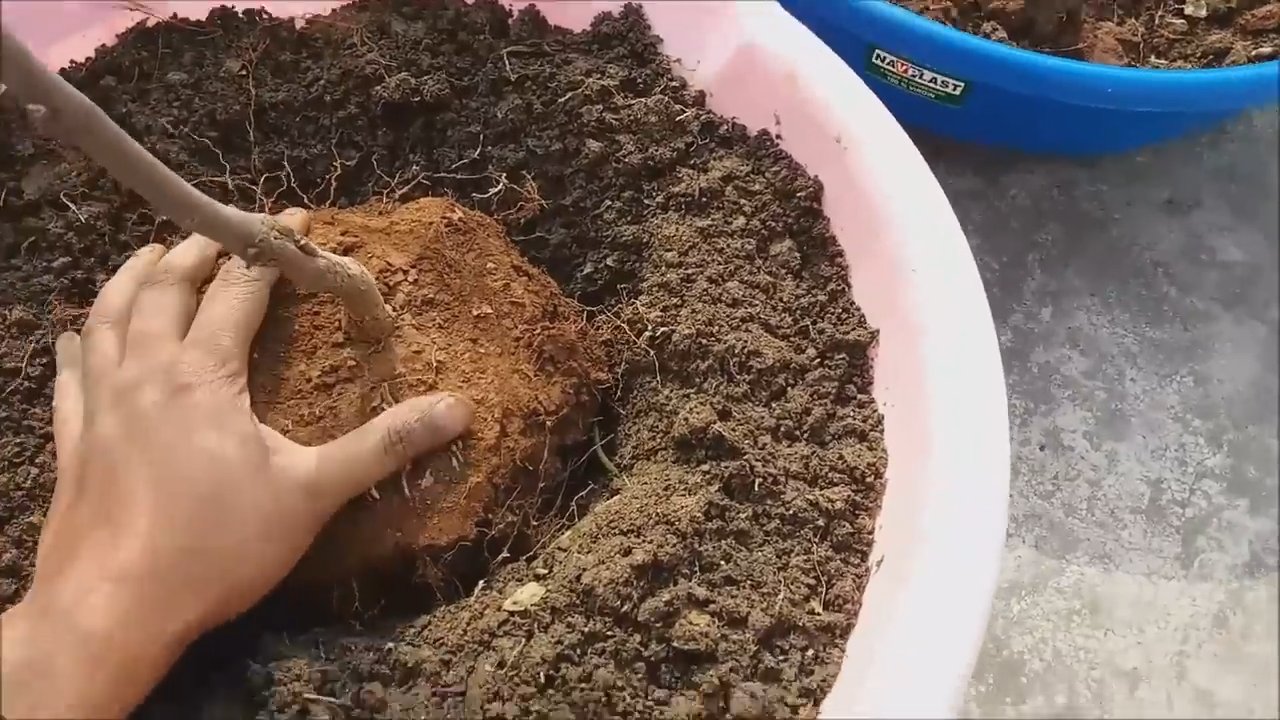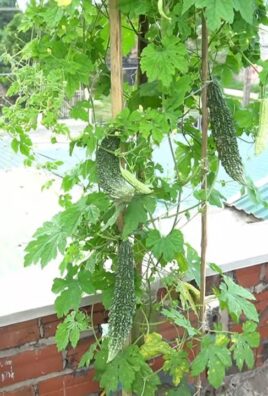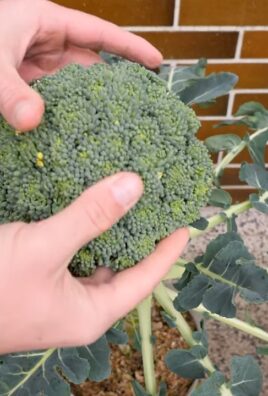Growing Jujube in Containers might sound like an exotic dream reserved for seasoned gardeners, but trust me, it’s totally achievable, even if you’re just starting out! Have you ever imagined stepping onto your balcony and plucking a sweet, date-like fruit straight from your own tree? That’s the magic we’re unlocking today!
Jujubes, also known as Chinese dates, have a rich history stretching back thousands of years in Asia, where they’re revered not only for their delicious flavor but also for their medicinal properties. In many cultures, they symbolize prosperity and are often given as gifts during celebrations. But you don’t need a sprawling orchard to enjoy these amazing fruits.
In today’s fast-paced world, space is often a luxury. Many of us live in apartments or homes with limited yard space, making traditional gardening a challenge. That’s where the beauty of container gardening comes in! Growing Jujube in Containers allows you to cultivate these delightful trees regardless of your spatial constraints. Plus, it gives you greater control over the growing environment, protecting your precious jujube from harsh weather and pests. I’m going to share some simple, yet effective DIY tricks and hacks that will have you harvesting your own homegrown jujubes in no time. Let’s get started!

Jujube im Topf ziehen: Dein DIY-Leitfaden für eine reiche Ernte
Hey Gartenfreunde! Habt ihr schon mal von Jujube gehört? Diese kleinen, dattelähnlichen Früchte sind nicht nur super lecker, sondern auch unglaublich gesund. Und das Beste: Ihr könnt sie auch ganz einfach im Topf auf eurem Balkon oder eurer Terrasse anbauen! Ich zeige euch, wie es geht.
Warum Jujube im Topf?
Jujube-Bäume sind eigentlich recht robust und können auch in kälteren Klimazonen überleben. Aber gerade in Regionen mit sehr kalten Wintern oder begrenztem Platzangebot ist die Topfkultur ideal. So könnt ihr den Baum im Winter einfach ins Haus holen und habt trotzdem jedes Jahr eine reiche Ernte. Außerdem könnt ihr so die Bodenbedingungen besser kontrollieren und sicherstellen, dass euer Jujube-Baum alles bekommt, was er braucht.
Was du brauchst: Die Materialliste
Bevor wir loslegen, hier eine Liste mit allem, was du für dein Jujube-Topfprojekt brauchst:
* Jujube-Baum (veredelt): Achtet darauf, eine veredelte Sorte zu kaufen, da diese früher und zuverlässiger Früchte tragen. Beliebte Sorten sind ‘Li’, ‘Lang’ oder ‘Sugar Cane’.
* Großer Topf: Der Topf sollte mindestens 40-50 cm Durchmesser haben. Je größer, desto besser, da der Baum Platz zum Wachsen braucht.
* Hochwertige Blumenerde: Eine gut durchlässige, nährstoffreiche Erde ist wichtig. Ich empfehle eine Mischung aus Blumenerde, Kompost und etwas Sand oder Perlit.
* Drainagematerial: Blähton, Kies oder Tonscherben für den Topfboden.
* Organischer Dünger: Hornspäne, Kompost oder ein spezieller Obstbaumdünger.
* Gießkanne oder Schlauch: Zum Bewässern.
* Gartenschere: Zum Beschneiden.
* Handschuhe: Zum Schutz deiner Hände.
* Mulchmaterial: Rindenmulch oder Stroh, um die Feuchtigkeit im Boden zu halten.
* Stützpfahl (optional): Für junge Bäume, die noch nicht so stabil sind.
Schritt-für-Schritt-Anleitung: So pflanzt du deinen Jujube-Baum
Jetzt geht’s ans Eingemachte! Hier ist eine detaillierte Anleitung, wie du deinen Jujube-Baum erfolgreich in einen Topf pflanzt:
1. Topf vorbereiten: Zuerst legen wir eine Schicht Drainagematerial (Blähton, Kies oder Tonscherben) auf den Boden des Topfes. Das sorgt dafür, dass das Wasser gut abfließen kann und die Wurzeln nicht faulen.
2. Erde einfüllen: Füllt den Topf mit eurer vorbereiteten Erdmischung. Lasst oben etwa 5-10 cm Platz bis zum Rand.
3. Baum vorbereiten: Nehmt den Jujube-Baum vorsichtig aus seinem Anzuchttopf. Lockert die Wurzeln etwas auf, falls sie stark verwurzelt sind.
4. Einpflanzen: Setzt den Baum mittig in den Topf. Die Oberseite des Wurzelballens sollte etwa auf gleicher Höhe mit der Erdoberfläche sein.
5. Auffüllen: Füllt den Topf mit Erde auf und drückt sie leicht an.
6. Gießen: Gießt den Baum gründlich an, bis das Wasser aus den Abzugslöchern läuft.
7. Mulchen: Verteilt eine Schicht Mulchmaterial (Rindenmulch oder Stroh) um den Baum herum. Das hilft, die Feuchtigkeit im Boden zu halten und Unkraut zu unterdrücken.
8. Stützpfahl (optional): Wenn der Baum noch jung und nicht so stabil ist, könnt ihr einen Stützpfahl anbringen, um ihn zu stabilisieren.
Die richtige Pflege: So bleibt dein Jujube-Baum glücklich
Einmal gepflanzt, braucht dein Jujube-Baum natürlich auch die richtige Pflege, um prächtig zu gedeihen und viele Früchte zu tragen.
Standort
Jujube-Bäume lieben die Sonne! Sucht einen sonnigen Standort für euren Topfbaum aus, an dem er mindestens 6-8 Stunden direkte Sonneneinstrahlung pro Tag bekommt. Ein Südbalkon oder eine Terrasse ist ideal.
Bewässerung
Jujube-Bäume sind relativ trockenheitsresistent, aber im Topf trocknet die Erde schneller aus. Gießt den Baum regelmäßig, besonders während der Wachstumsperiode und an heißen Tagen. Achtet darauf, dass die Erde zwischen den Wassergaben leicht antrocknen kann. Vermeidet Staunässe, da dies zu Wurzelfäule führen kann.
Düngung
Jujube-Bäume sind nicht besonders anspruchsvoll, aber eine regelmäßige Düngung fördert das Wachstum und die Fruchtbildung. Düngt den Baum im Frühjahr mit einem organischen Dünger (Hornspäne, Kompost oder ein spezieller Obstbaumdünger). Wiederholt die Düngung im Sommer noch einmal.
Beschneidung
Das Beschneiden ist wichtig, um die Form des Baumes zu erhalten und die Fruchtbildung zu fördern. Schneidet den Baum im späten Winter oder frühen Frühjahr, bevor er austreibt. Entfernt abgestorbene, kranke oder sich kreuzende Äste. Kürzt die Triebe ein, um die Verzweigung zu fördern.
Überwinterung
Jujube-Bäume sind winterhart, aber im Topf sind die Wurzeln anfälliger für Frostschäden. In Regionen mit sehr kalten Wintern solltet ihr den Baum ins Haus holen oder ihn zumindest mit Vlies oder Jute schützen. Stellt den Baum an einen kühlen, hellen Ort und gießt ihn nur sparsam.
Häufige Probleme und Lösungen
Auch beim Anbau von Jujube-Bäumen im Topf können mal Probleme auftreten. Hier sind einige häufige Probleme und wie ihr sie lösen könnt:
* Blattfall: Blattfall kann verschiedene Ursachen haben, wie z.B. Wassermangel, Nährstoffmangel oder Schädlinge. Überprüft die Bewässerung und Düngung und behandelt den Baum gegebenenfalls mit einem geeigneten Pflanzenschutzmittel.
* Keine Früchte: Wenn euer Jujube-Baum keine Früchte trägt, kann das an mangelnder Bestäubung liegen. Jujube-Bäume sind selbstfruchtbar, aber eine Fremdbestäubung kann den Ertrag erhöhen. Ihr könnt die Bestäubung unterstützen, indem ihr die Blüten mit einem Pinsel bestäubt oder einen zweiten Jujube-Baum in der Nähe pflanzt.
* Schädlinge: Jujube-Bäume sind relativ resistent gegen Schädlinge, aber gelegentlich können Blattläuse oder Spinnmilben auftreten. Behandelt den Baum mit einem geeigneten Pflanzenschutzmittel oder mit natürlichen Mitteln wie z.B. Brennnesseljauche.
* Wurzelfäule: Wurzelfäule wird durch Staunässe verursacht. Achtet darauf, dass das Wasser gut abfließen kann und die Erde zwischen den Wassergaben leicht antrocknen kann.
Erntezeit: Die süße Belohnung
Nach all der Mühe kommt natürlich auch die Belohnung: die Ernte! Jujube-Früchte sind reif, wenn sie eine braune oder rötliche Farbe haben und sich leicht vom Baum lösen lassen. Die Erntezeit ist meist im Spätsommer oder Herbst. Die Früchte können frisch gegessen, getrocknet oder zu Marmelade, Saft oder Likör verarbeitet werden.
Zusätzliche Tipps für eine reiche Ernte
* Wählt die richtige Sorte: Nicht alle Jujube-Sorten sind gleich gut für den Anbau im Topf geeignet. Informiert euch vor dem Kauf, welche Sorte für eure Region und eure Bedürfnisse am besten geeignet ist.
* Achtet auf die Bodenqualität: Eine gute Bodenqualität ist entscheidend für das Wachstum und die Fruchtbildung. Verwendet eine hochwertige Blumenerde und düngt den Baum regelmäßig.
* Schützt den Baum vor extremen Wetterbedingungen: Jujube-Bäume sind zwar robust, aber extreme Hitze, Kälte oder Wind können ihnen schaden. Schützt den Baum gegebenenfalls mit einem Sonnensegel, Vlies oder einem Windschutz.
* Seid geduldig: Jujube-Bäume brauchen etwas Zeit, bis sie Früchte tragen. Habt Geduld und gebt dem Baum die richtige Pflege, dann werdet ihr mit einer reichen Ernte belohnt.
Ich hoffe, dieser Leitfaden hat

Conclusion
So, there you have it! Growing jujube in containers isn’t just a possibility; it’s a rewarding and surprisingly accessible endeavor. We’ve walked through the essential steps, from selecting the right variety and container to providing the necessary care and attention. But why should you embark on this journey? Because cultivating your own jujube tree, even in a limited space, offers a unique connection to nature, a satisfying sense of accomplishment, and, of course, a bounty of delicious and nutritious fruit.
Think about it: fresh, homegrown jujubes, bursting with flavor, right at your fingertips. No more relying on expensive imports or limited availability. You control the growing process, ensuring the highest quality and avoiding harmful pesticides. Plus, the jujube tree itself is a beautiful addition to any patio, balcony, or garden, offering visual appeal throughout the seasons.
This DIY trick is a must-try for several reasons. First, it democratizes fruit growing. You don’t need acres of land to enjoy the fruits of your labor. Second, it’s a sustainable practice. Growing your own food reduces your carbon footprint and promotes a healthier lifestyle. Third, it’s a fun and educational experience. You’ll learn about plant biology, soil science, and the intricacies of fruit production.
But the benefits don’t stop there. Growing jujube in containers allows for greater control over the growing environment. You can easily move your tree to a sheltered location during harsh weather, protect it from pests and diseases, and optimize its exposure to sunlight. This level of control can lead to higher yields and better-quality fruit.
Now, let’s talk about variations. While we’ve focused on the general principles of container jujube growing, there’s plenty of room for experimentation. Consider trying different soil mixes to find the one that works best for your climate and growing conditions. Explore different training techniques to shape your tree and maximize fruit production. And don’t be afraid to graft different jujube varieties onto a single rootstock to create a multi-flavored tree.
For example, if you live in a particularly hot and dry climate, you might want to amend your soil with extra water-retaining materials like coco coir or peat moss. If you’re dealing with limited sunlight, consider using grow lights to supplement natural light. And if you’re concerned about pests, try companion planting with herbs like basil or rosemary, which can help repel unwanted insects.
Another exciting variation is to experiment with different container sizes and materials. While we recommend a minimum of 15 gallons, you might find that a larger container allows for even better root development and fruit production. And while plastic containers are a popular choice, you could also try using terracotta pots, which offer better drainage and aeration.
Ultimately, the best way to learn is by doing. So, we encourage you to take the plunge and try growing jujube in containers. Don’t be afraid to make mistakes – they’re all part of the learning process. And most importantly, have fun!
We’re confident that you’ll be amazed by the results. Imagine the satisfaction of harvesting your own homegrown jujubes, sharing them with friends and family, and knowing that you’ve created something truly special.
So, what are you waiting for? Grab a container, some soil, and a jujube tree, and get started today! And once you’ve had some experience, we’d love to hear about it. Share your tips, tricks, and successes in the comments below. Let’s build a community of container jujube growers and learn from each other. Your experiences could inspire others to embark on this rewarding journey. Let us know how your **growing jujube in containers** is going!
Frequently Asked Questions (FAQ)
1. What is the best jujube variety to grow in a container?
The best jujube variety for container growing depends on your climate and personal preferences. However, some popular and reliable choices include ‘Li,’ ‘Lang,’ and ‘Sherwood.’ ‘Li’ is known for its large, round fruit and early ripening. ‘Lang’ produces pear-shaped fruit with a slightly tart flavor. ‘Sherwood’ is a smaller tree, making it well-suited for containers, and it produces sweet, flavorful fruit. Consider your local climate and the availability of these varieties when making your selection. Also, look for self-pollinating varieties to ensure fruit production without needing a second tree.
2. What size container do I need for a jujube tree?
A minimum of 15 gallons is recommended for growing jujube in containers. However, a larger container, such as 20 or 25 gallons, will provide more room for root development and can lead to better fruit production. Choose a container that is sturdy, has good drainage holes, and is made of a material that won’t overheat in the sun. Plastic containers are a popular and affordable option, but terracotta pots can also be used, providing better aeration.
3. What type of soil is best for container-grown jujube trees?
Jujube trees prefer well-draining soil that is slightly acidic to neutral (pH 6.0-7.0). A good potting mix for container-grown jujubes should consist of a combination of ingredients such as:
* **Potting soil:** Provides a base for the mix.
* **Compost:** Adds nutrients and improves drainage.
* **Perlite or vermiculite:** Enhances drainage and aeration.
* **Sand:** Improves drainage and prevents compaction.
Avoid using garden soil in containers, as it can become compacted and poorly drained. A well-draining soil mix is crucial for preventing root rot and ensuring healthy growth.
4. How often should I water my container-grown jujube tree?
Watering frequency depends on several factors, including the size of the container, the type of soil, the climate, and the age of the tree. In general, water your jujube tree when the top inch of soil feels dry to the touch. Water deeply, until water drains out of the drainage holes. Avoid overwatering, as this can lead to root rot. During hot, dry weather, you may need to water more frequently. During cooler, wetter weather, you may need to water less frequently. Monitor the soil moisture regularly and adjust your watering schedule accordingly.
5. How much sunlight does a jujube tree need?
Jujube trees need at least 6-8 hours of direct sunlight per day to thrive and produce fruit. Choose a location for your container-grown jujube tree that receives plenty of sunlight. If you live in a climate with limited sunlight, consider using grow lights to supplement natural light. Rotate the container regularly to ensure that all sides of the tree receive adequate sunlight.
6. Do I need to fertilize my container-grown jujube tree?
Yes, fertilizing is important for container-grown jujube trees, as the nutrients in the soil will eventually be depleted. Fertilize your tree in the spring and summer with a balanced fertilizer that is specifically formulated for fruit trees. Follow the instructions on the fertilizer label carefully. Avoid over-fertilizing, as this can damage the tree. You can also amend the soil with compost or other organic matter to provide a slow-release source of nutrients.
7. How do I prune a container-grown jujube tree?
Pruning is important for maintaining the shape and size of your container-grown jujube tree, as well as for promoting fruit production. Prune your tree in the late winter or early spring, before new growth begins. Remove any dead, damaged, or crossing branches. Thin out the canopy to allow for better air circulation and sunlight penetration. You can also prune to shape the tree and control its size.
8. How do I protect my container-grown jujube tree from pests and diseases?
Container-grown jujube trees are generally resistant to pests and diseases. However, it’s still important to monitor your tree regularly for any signs of problems. Common pests that may affect jujube trees include aphids, scale, and spider mites. Diseases that may affect jujube trees include fungal diseases such as powdery mildew and rust. If you notice any pests or diseases, treat them promptly with appropriate insecticides or fungicides. You can also use organic pest control methods, such as neem oil or insecticidal soap.
9. Can I move my container-grown jujube tree indoors during the winter?
Whether you can move your container-grown jujube tree indoors during the winter depends on your climate and the hardiness of the variety. Jujube trees are generally hardy to USDA zones 6-9. If you live in a colder climate, you may need to protect your tree from freezing temperatures. You can either move the container indoors to a cool, bright location, or you can wrap the container with insulation to protect the roots. If you move the tree indoors, reduce watering and fertilizing during the winter months.
10. How long does it take for a container-grown jujube tree to produce fruit?
The time it takes for a container-grown jujube tree to produce fruit depends on the variety, the age of the tree, and the growing conditions. Grafted jujube trees typically begin to produce fruit within 1-3 years of planting. Seedling trees may take longer to produce fruit. To encourage fruit production, provide your tree with plenty of sunlight, water, and fertilizer. Prune the tree regularly to promote air circulation and sunlight penetration. And be patient – it may take




Leave a Comment